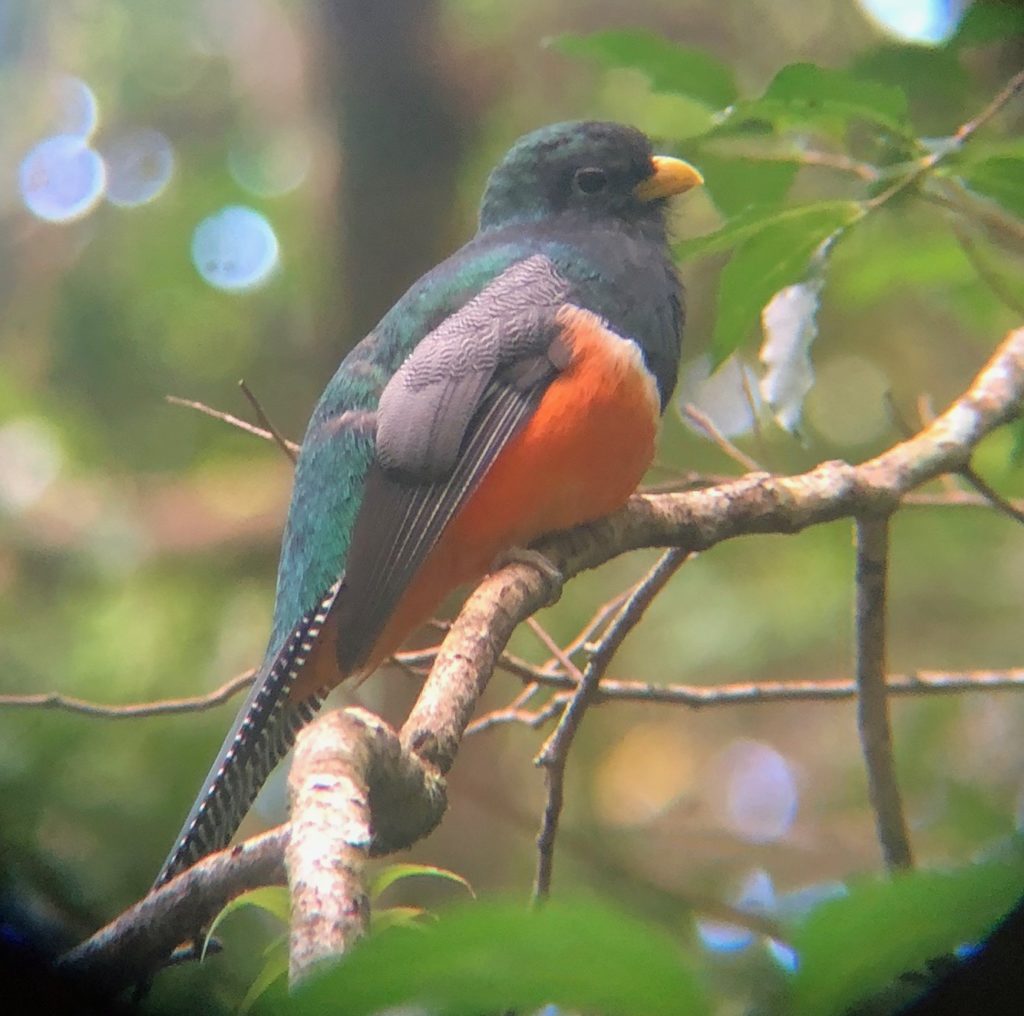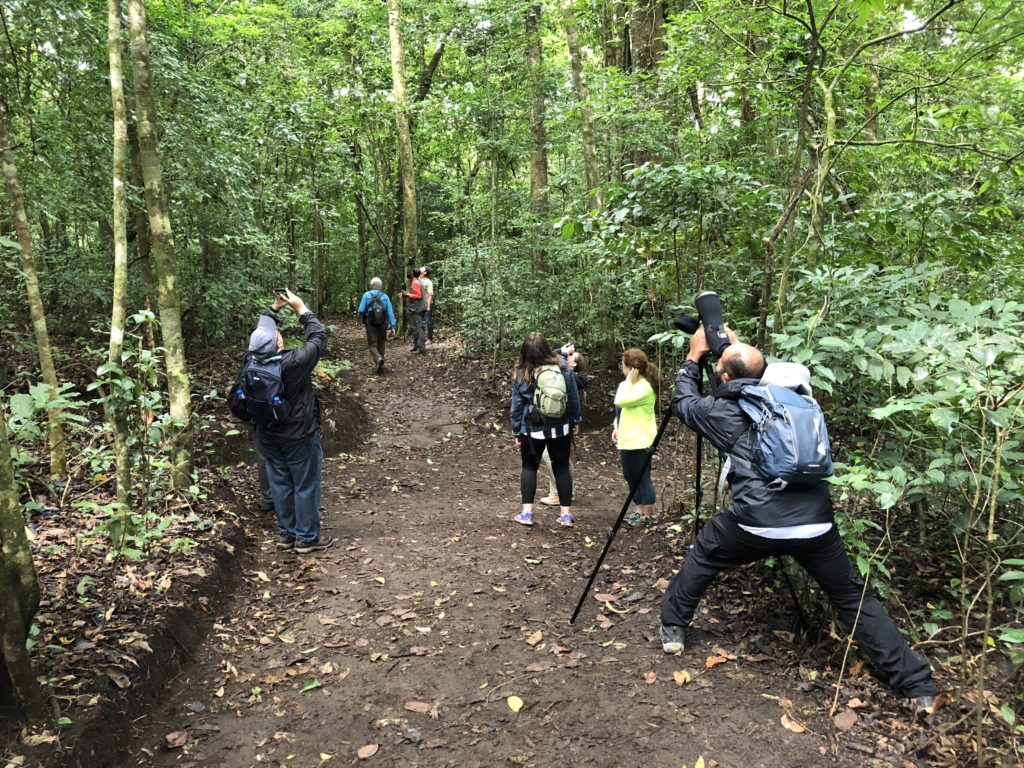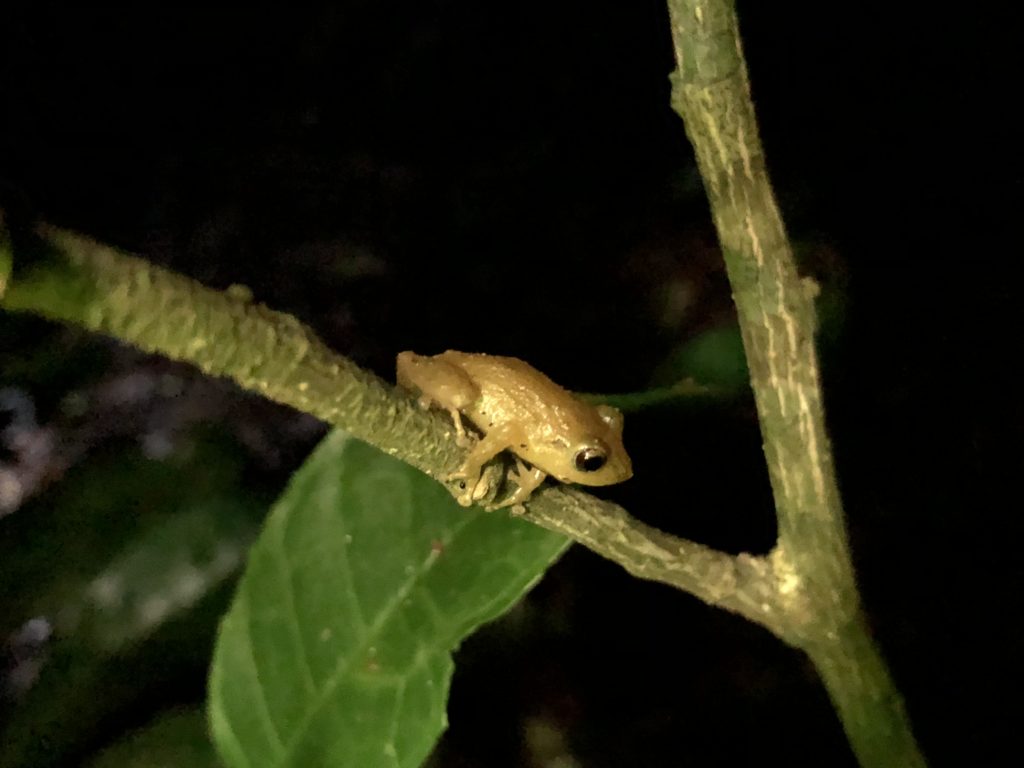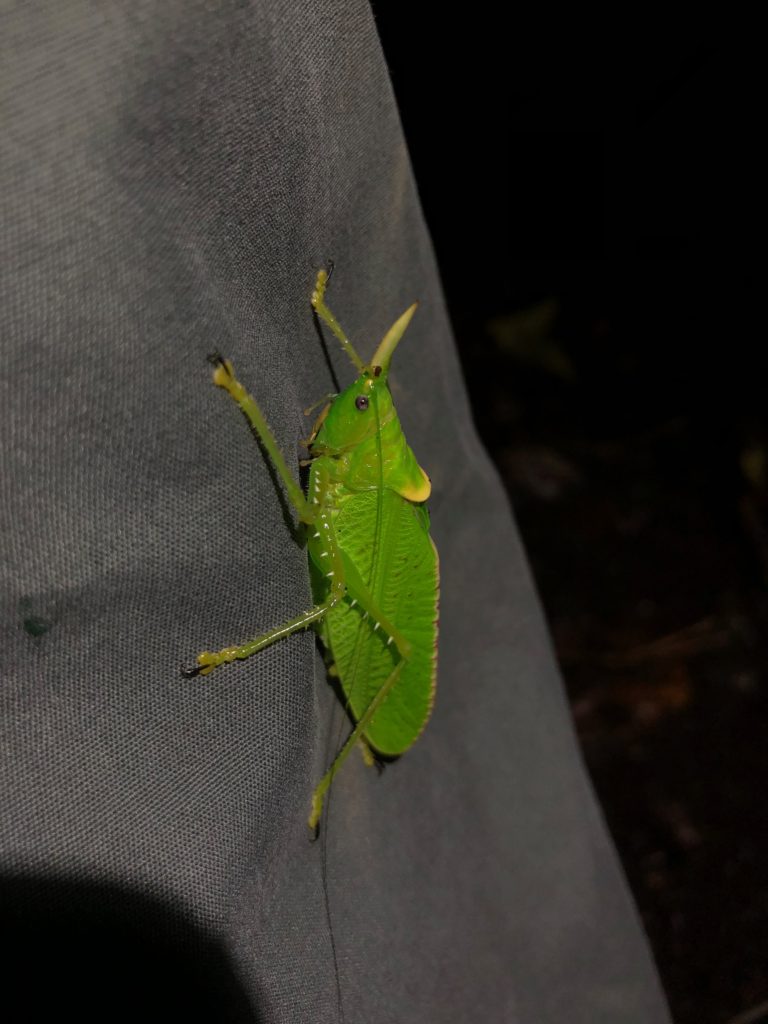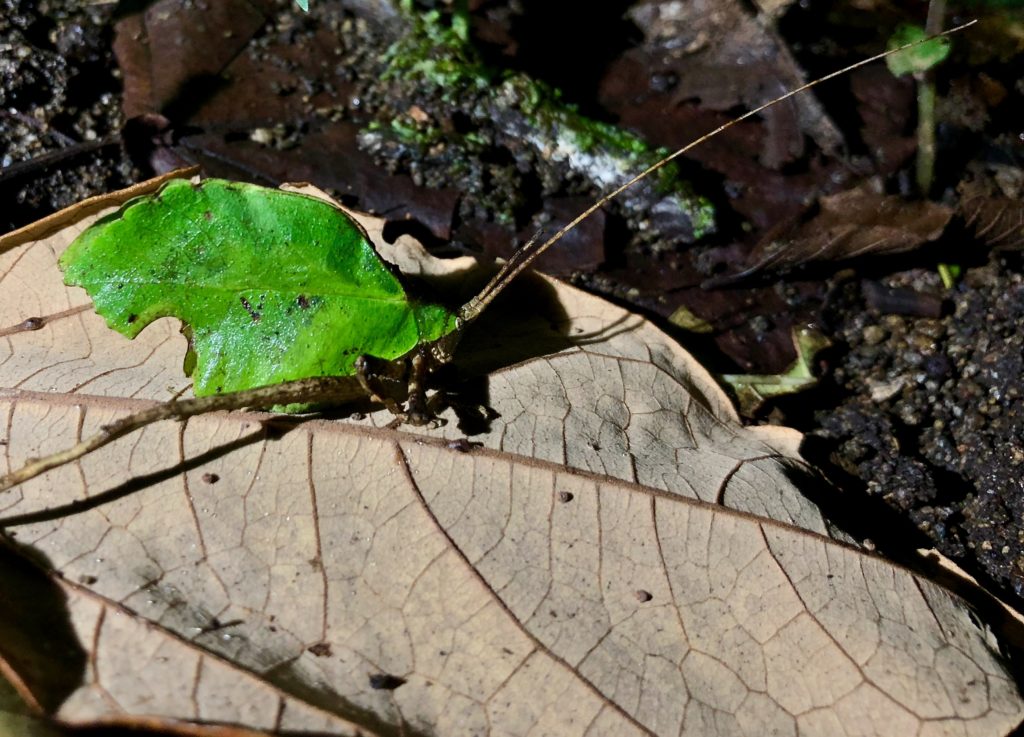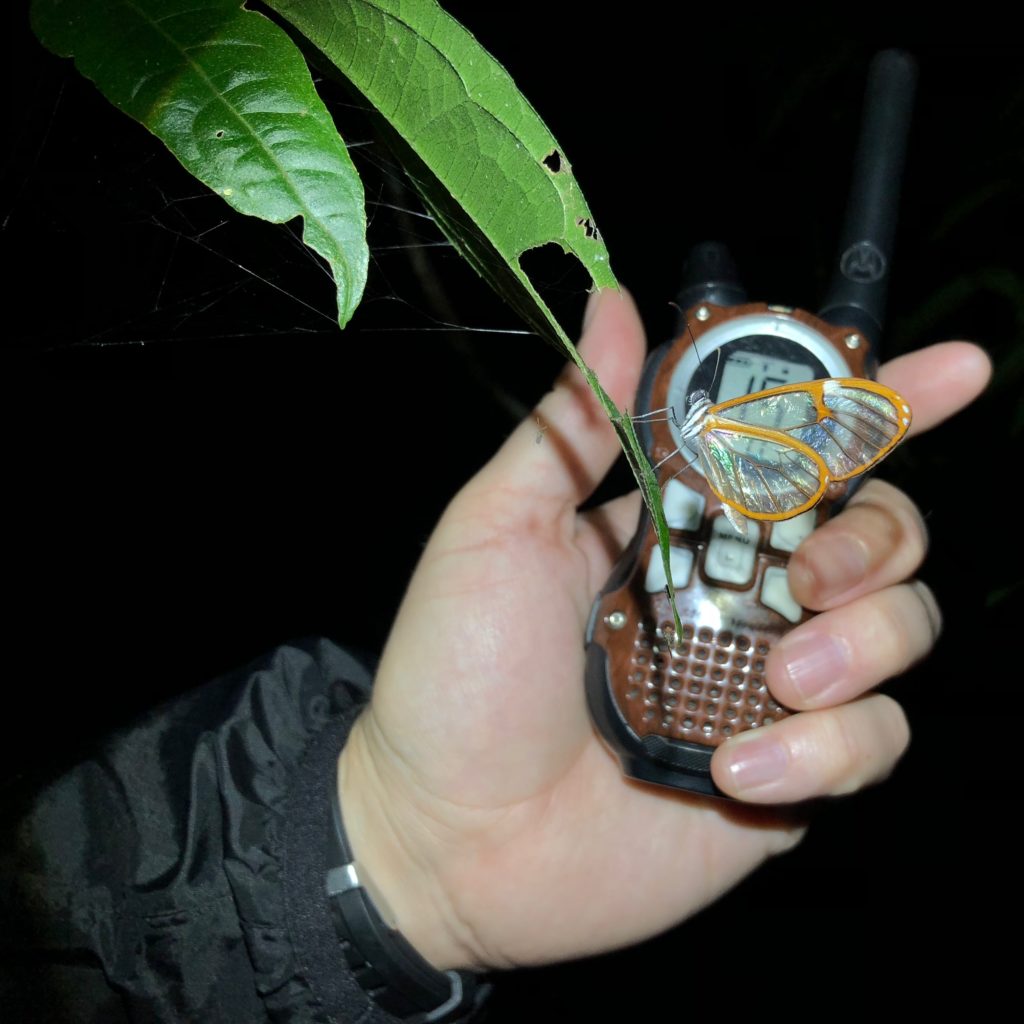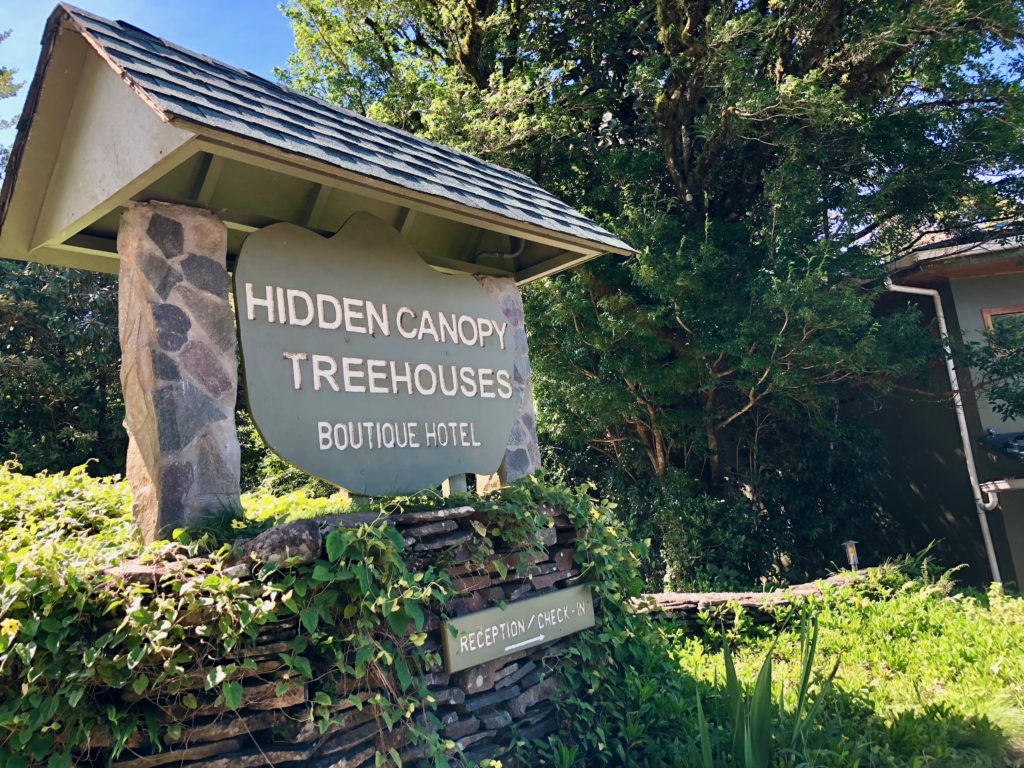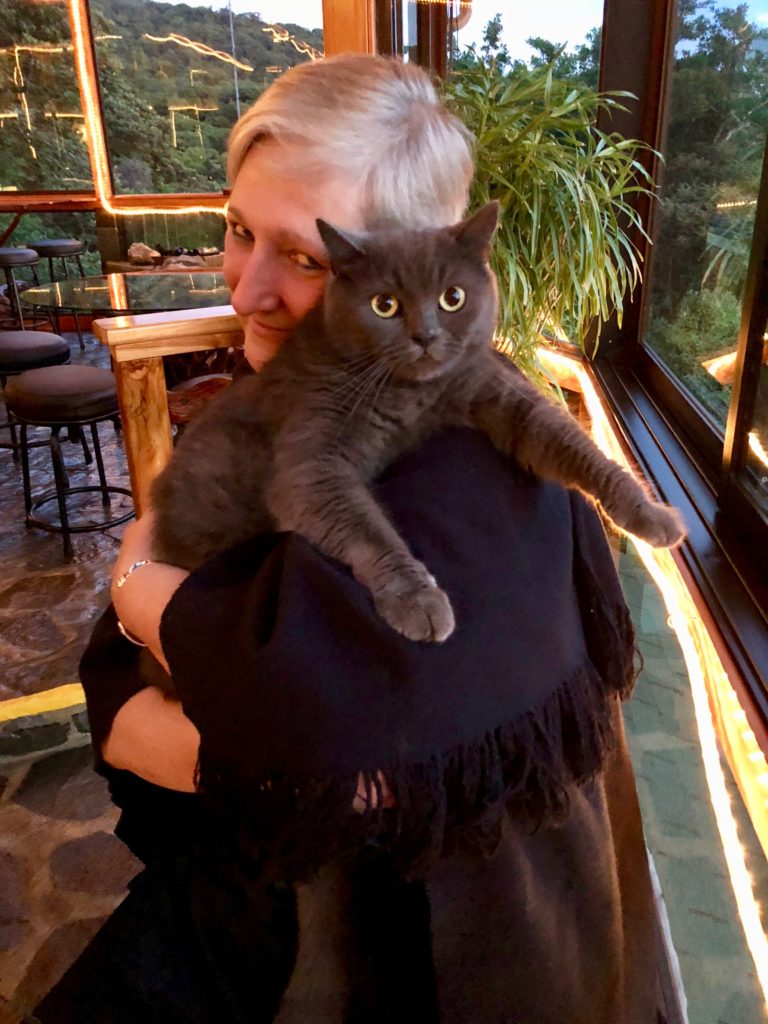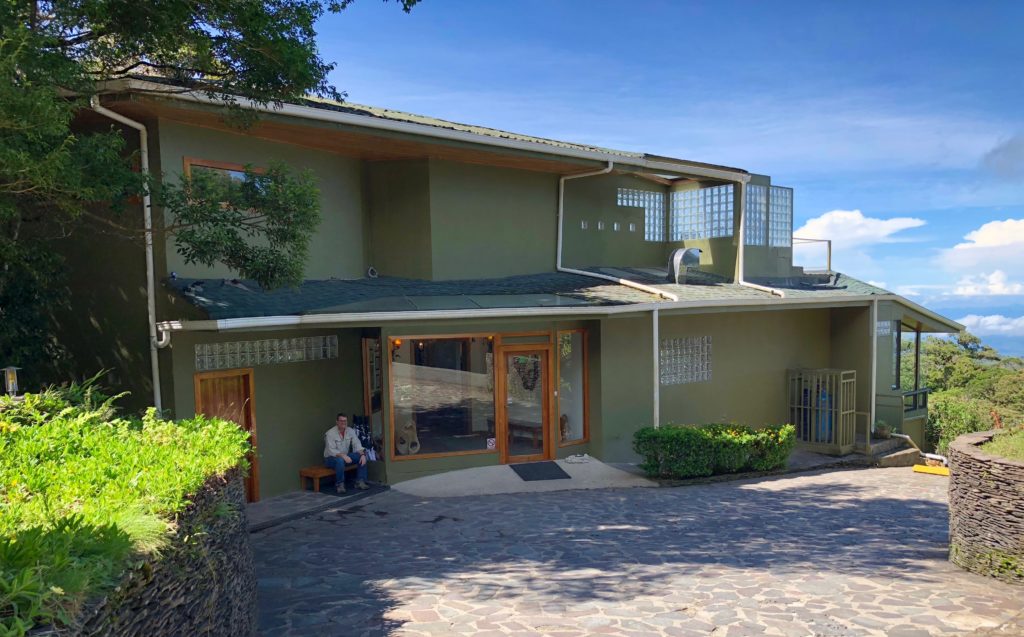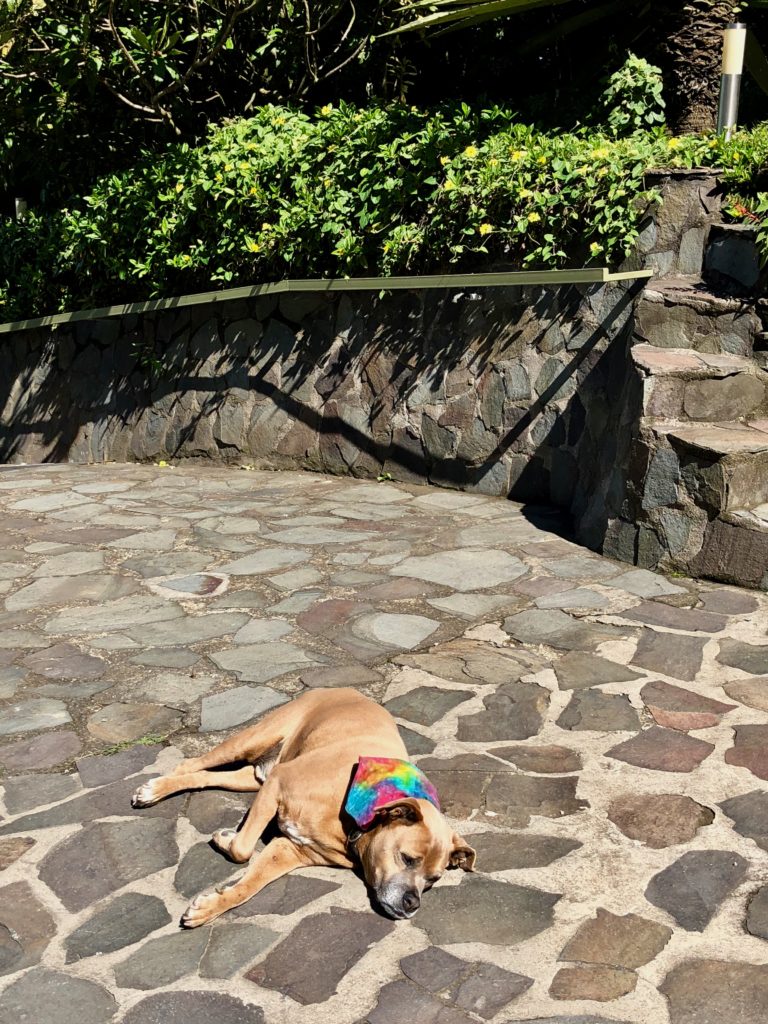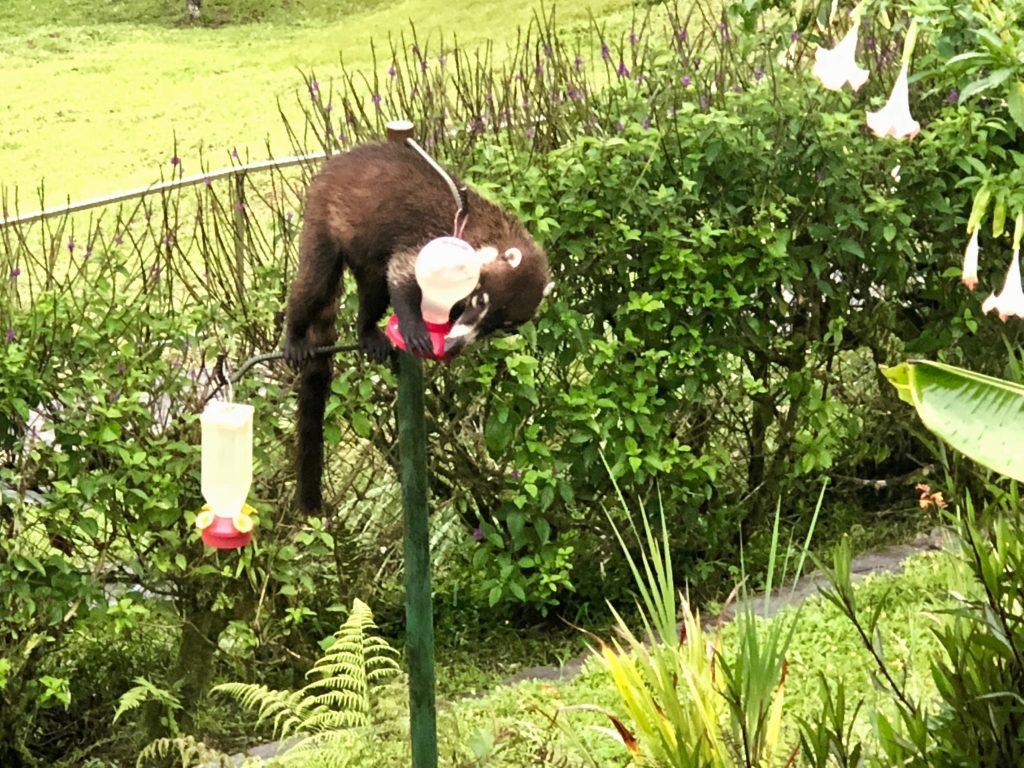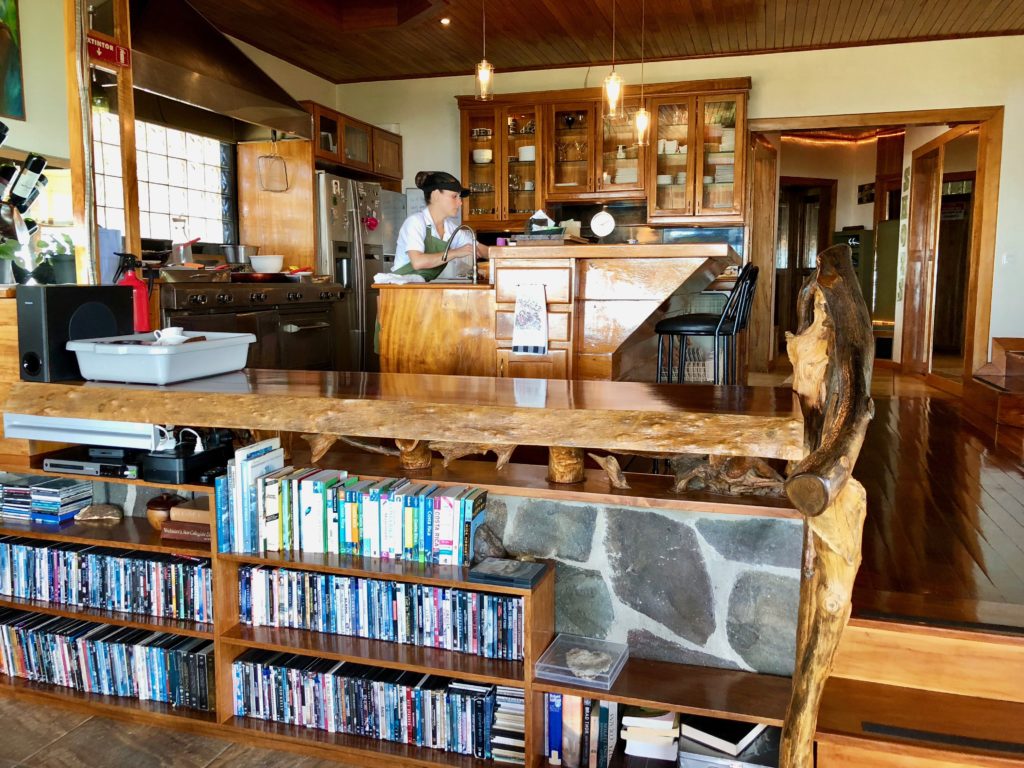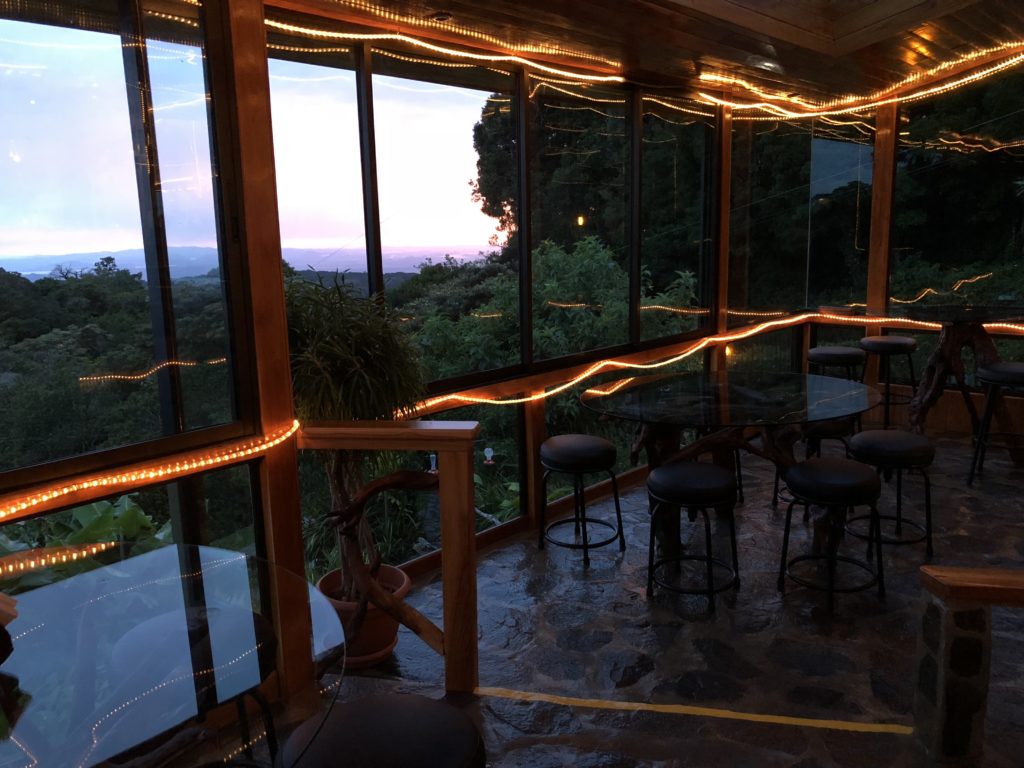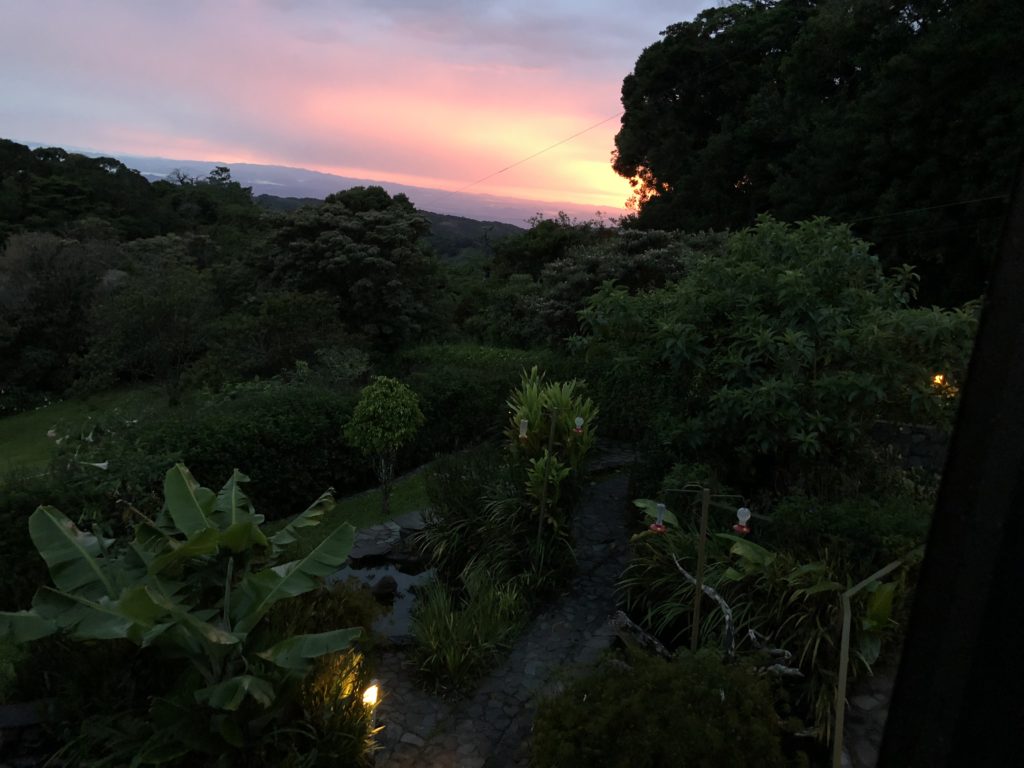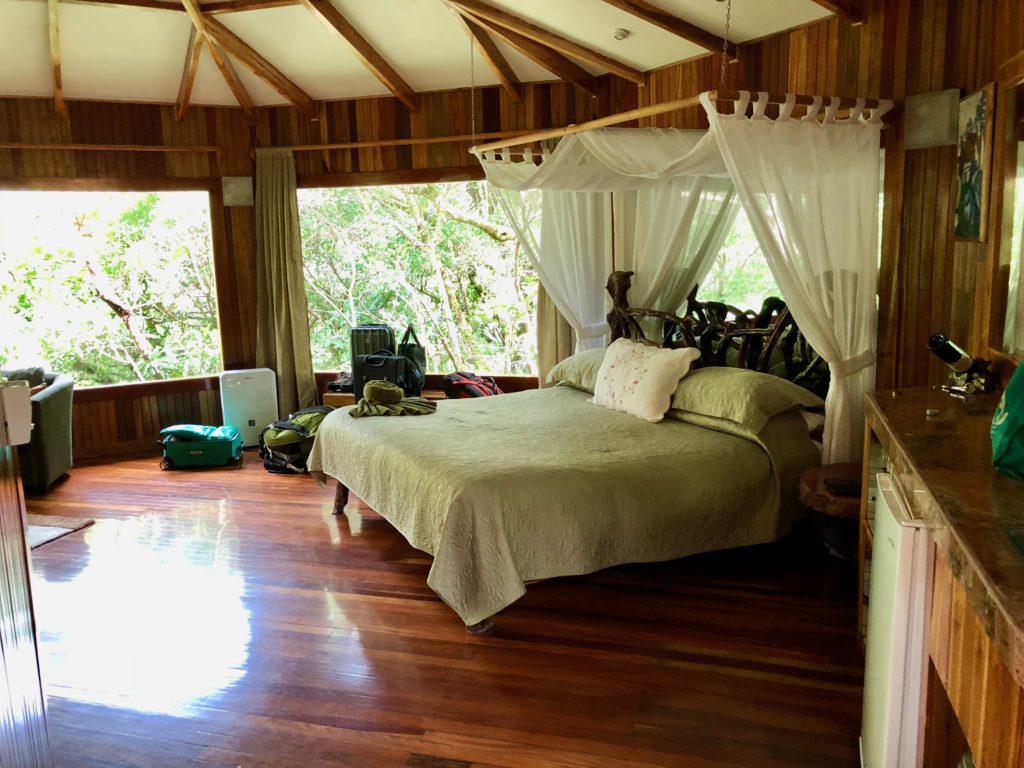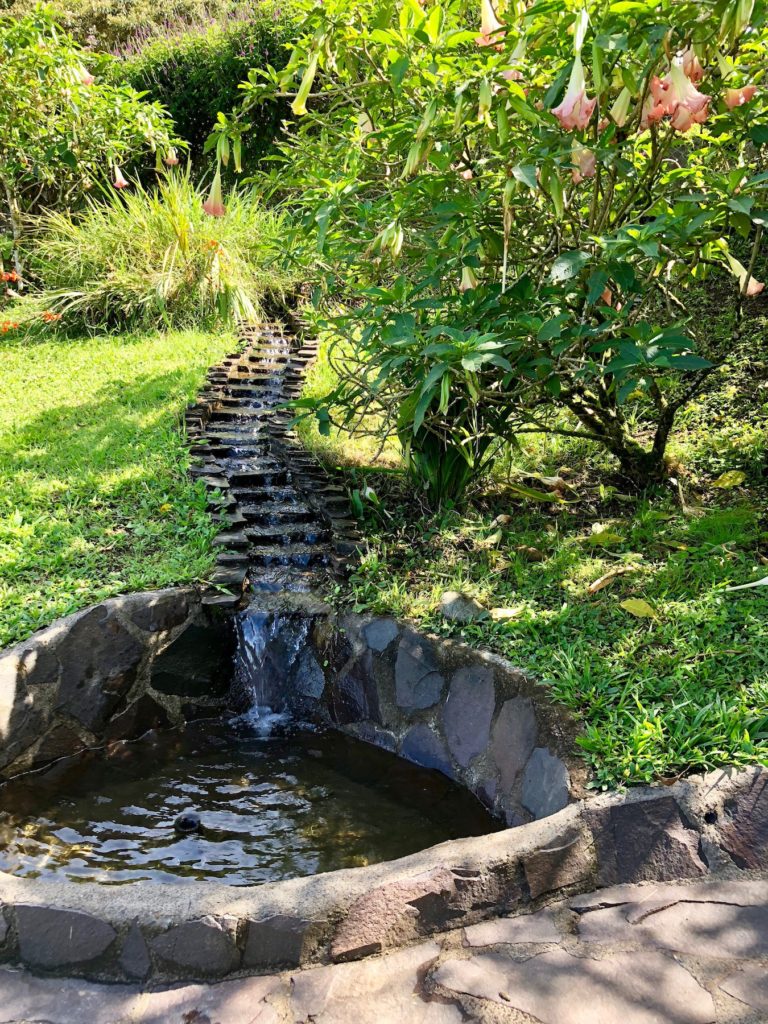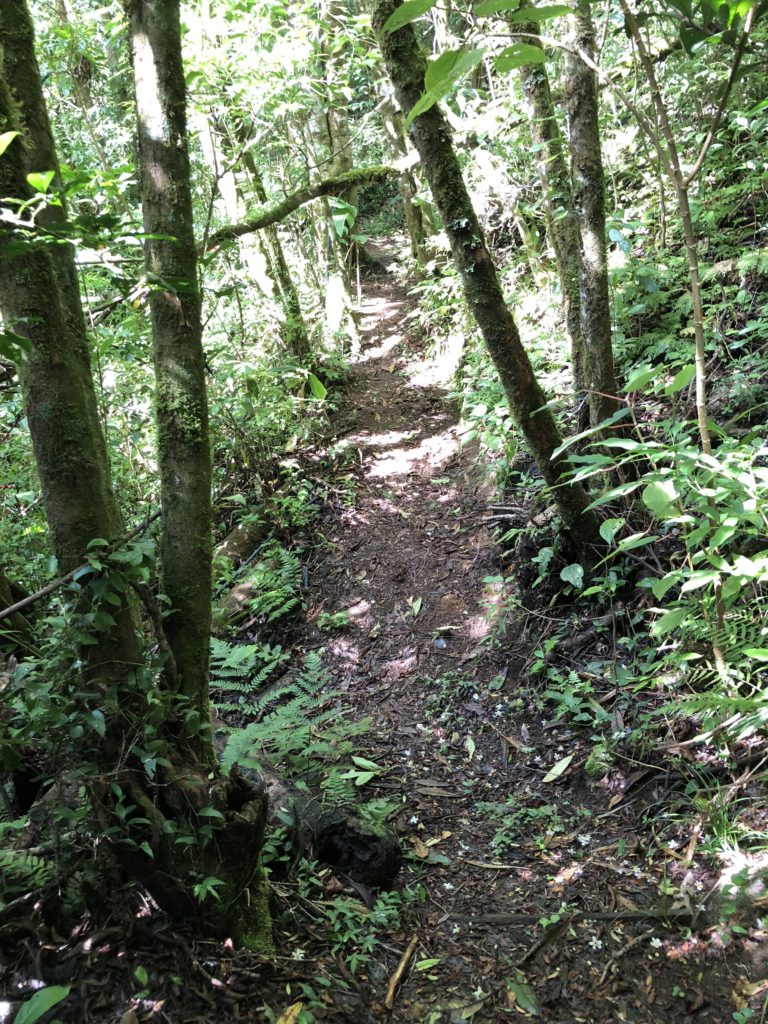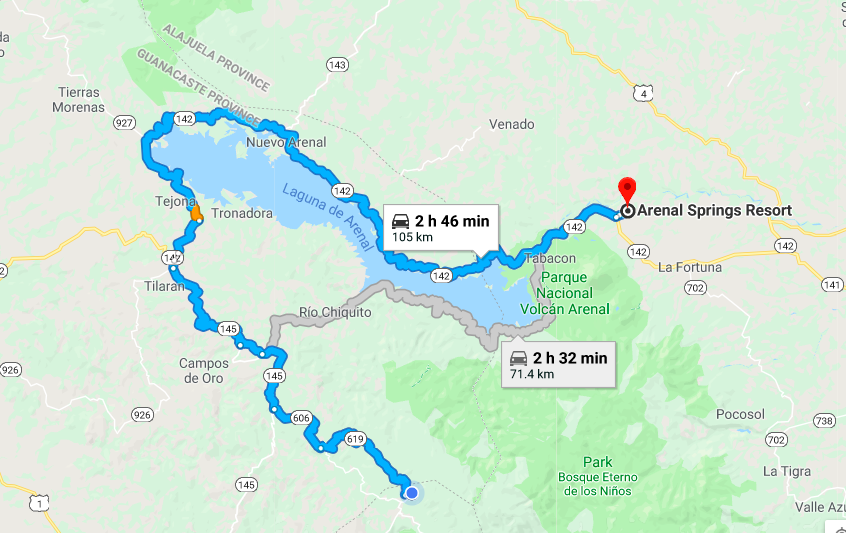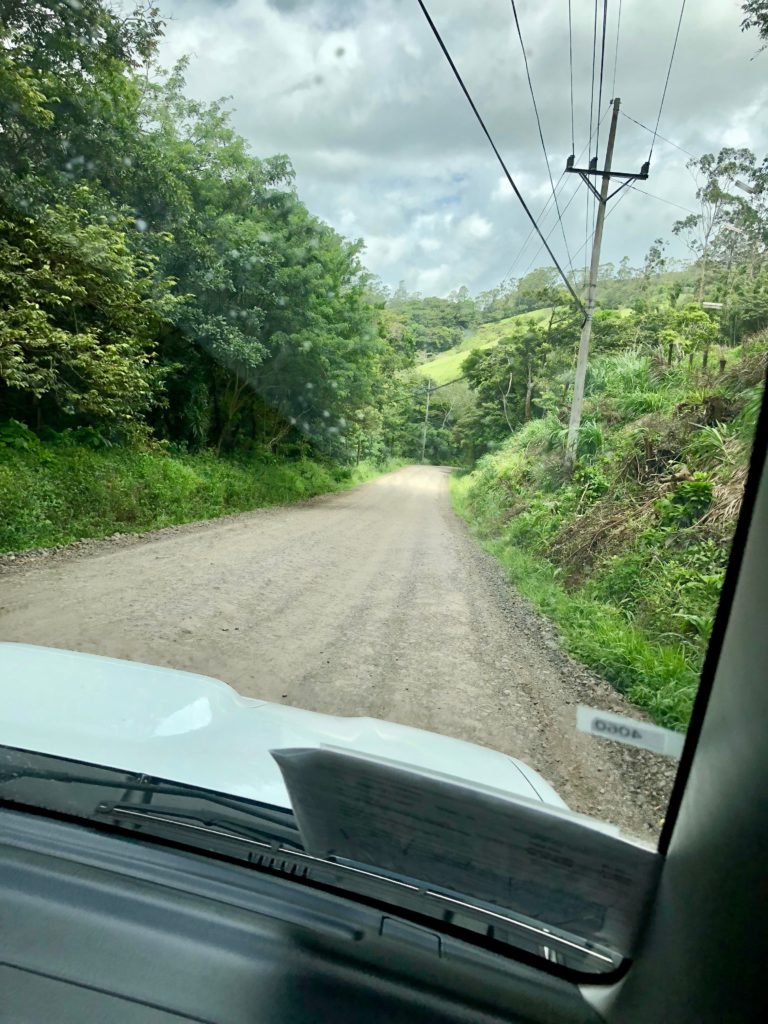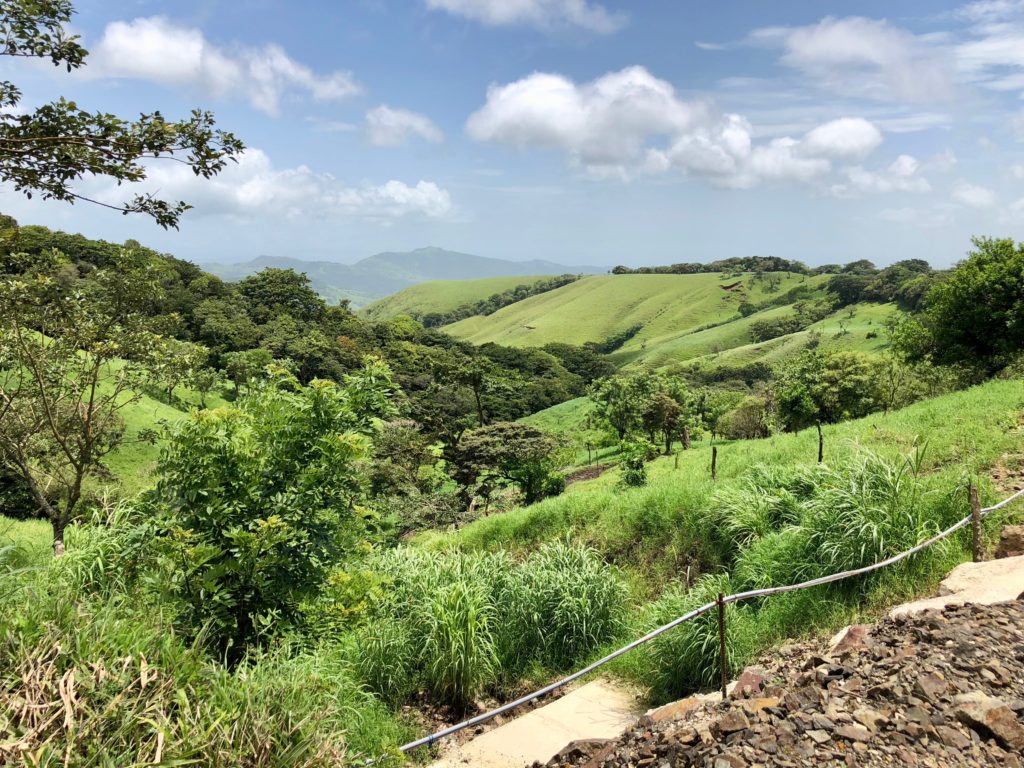I’ve already waxed schmaltzy about our accommodations here in Monteverde: the magical Hidden Canopy Treehouses Boutique Hotel. What I haven’t mentioned is the resident guide, Koky Porras. We were strongly encouraged to book a tour with Koky, and you know I’m not one to walk away from a guided tour. That said, we had just finished two nature walks with guides in La Fortuna, so it was hard to imagine what could be so special about this guy.
Now I know.
He. Is. Brilliant.
Not just at finding and naming animals in the forest (which he does with an almost eery sixth sense). He also loves his job and takes pride in continuing to learn. He shared his stories of growing up here and evolving from a youngster charging through the forest with a slingshot to a deeply knowledgable naturalist who relishes an opportunity to teach others about the interconnectedness of living things. It was an honor to spend time with someone with such a gentle reverance for this ecosystem.
Koky hangs out with the guests during tea time at the hotel to chat about the area, wildlife, and his own personal experiences. While I was meeting other tourists and sipping red wine on our first evening, Koky borrowed my phone and shot this video through his telescope of a violet sabrewing hummingbird hovering at one of the garden feeders.
He also showed us how a scorpion (found by Jenn on the property) glows under an ultraviolet light.
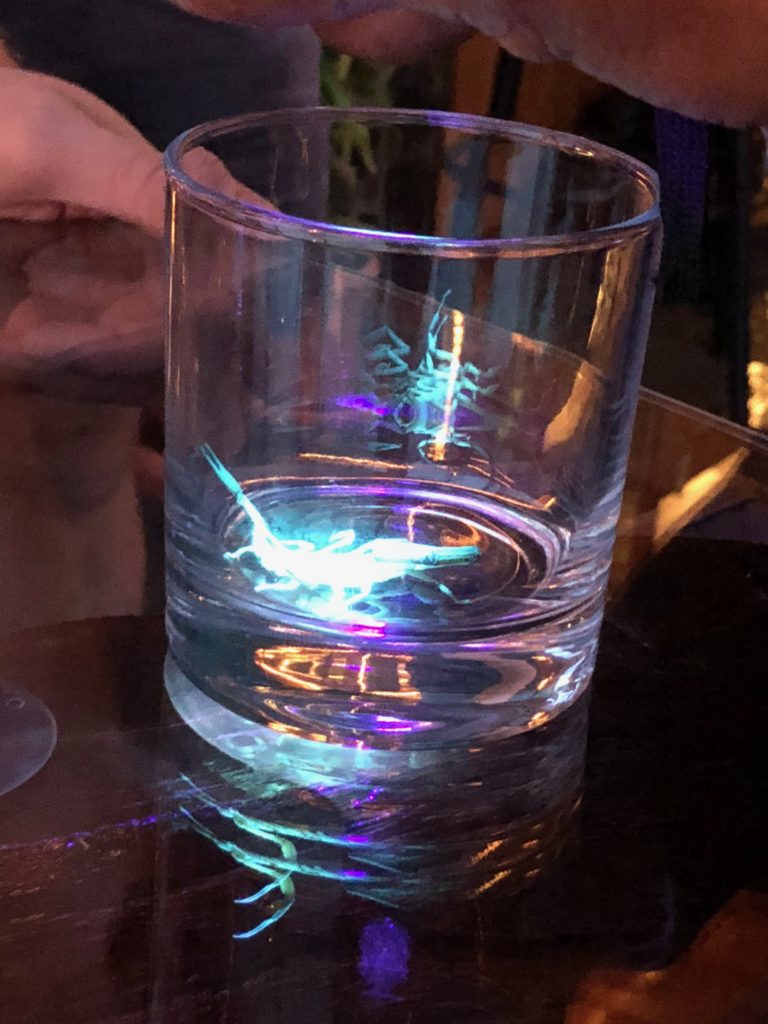
I asked Koky how a rainforest differs from a cloud forest. He said it’s all about microclimates. A change of just 500 meters elevation has a big impact on the temperature and rainfall of a region, which ultimately determines which plants and animals can survive there. Monteverde is located in a high-elevation cloud forest, which tends to be cooler than the lowland forests. Most of the moisture comes from mist and clouds.
One of my favorite Koky anecdotes centered on the concept that trees in the forest play host to so many other plants. He told of some researchers who spent time in Monteverde studying just one tree. They ultimately counted and identified more than 120 plants living on that tree. Koky said he likes to use that story to pose powerful questions to the children he teaches, including his own. “I like to ask them, who pollinates each of those 120 plants? Is it bees or birds or bats? And who eats the fruit from those plants? And who eats the animals who eat those fruits? And what happens when those animals die and decompose? Who eats them then? You can see that cutting down just that one tree impacts the whole ecosystem.”
I consider myself fairly eco-conscious, but that story was a wake-up call. It’s so easy in our busy lives to forget that our actions can have major repercussions and that humans leave big footprints.
On our first full day here, we took two tours with Koky. We were joined by sisters, Lauren and Emily, for the morning hike to the Curi-Cancha Reserve. Koky carried his scope, binoculars, and several guidebooks for our reference. While we were still driving in town, he noticed a two-toed sloth in a tree, so we stopped for a quick look.
“All you can see is a furball,” Koky laughed.
At the reserve, Koky demonstrated his wicked iPhone photography skills by taking a vertical pano of Tony and me in front of this massive ficus tree. (Who knew you could take vertical panoramas?)
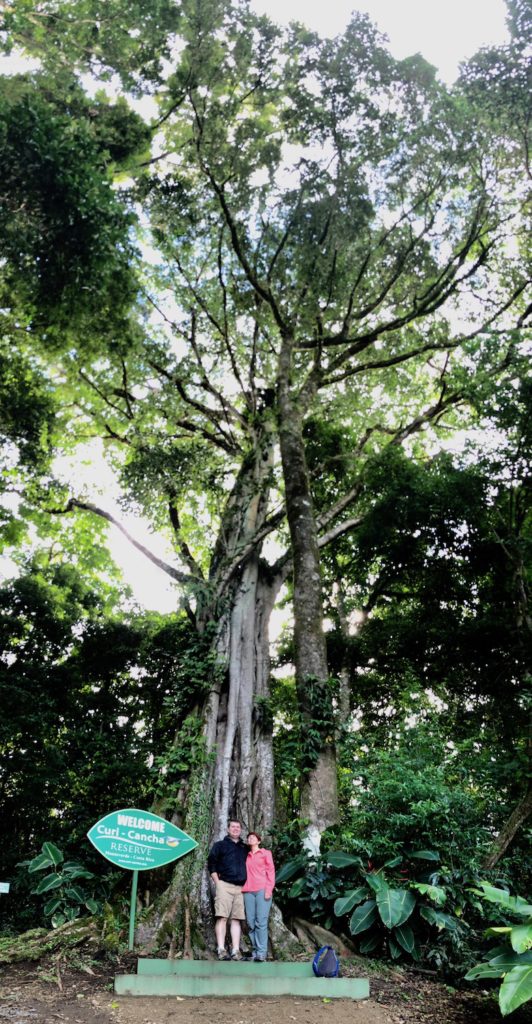
Koky listened astutely and mimicked the sounds of birds, frogs, and insects to track them.
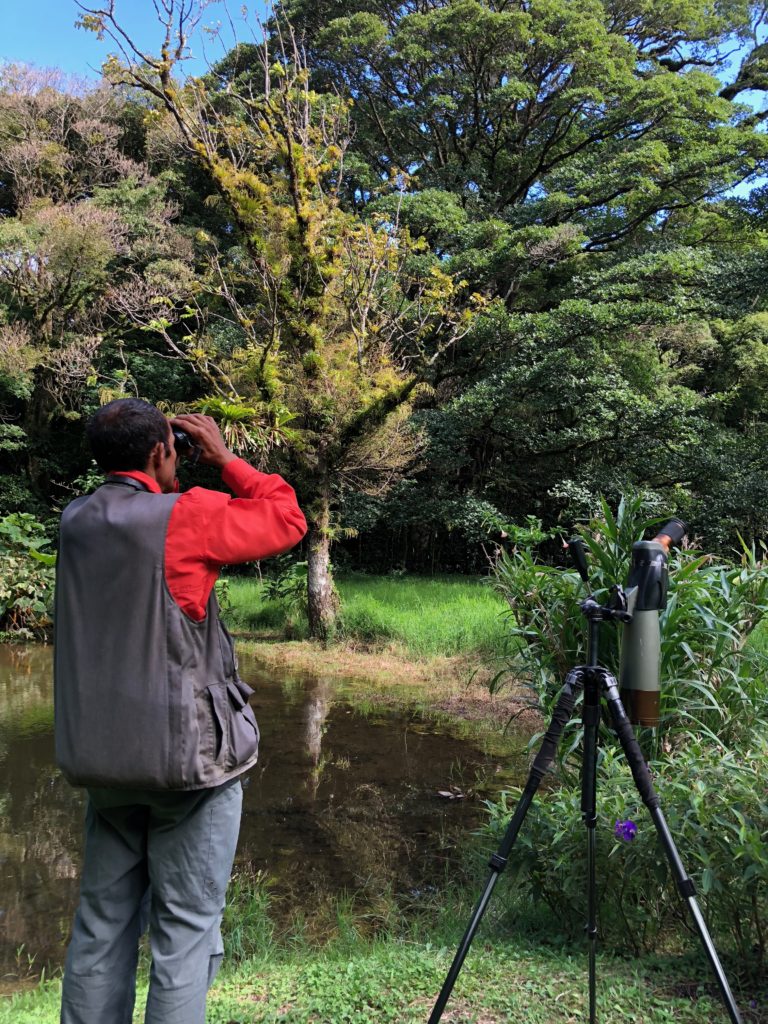
Koky pointed out the clay-colored thrush and said, “That’s our national bird. We’re always a little embarrassed that we have all these beautiful colorful birds, but that’s our national bird.” I didn’t get a photo, but this one is from the website CostaRica.com.
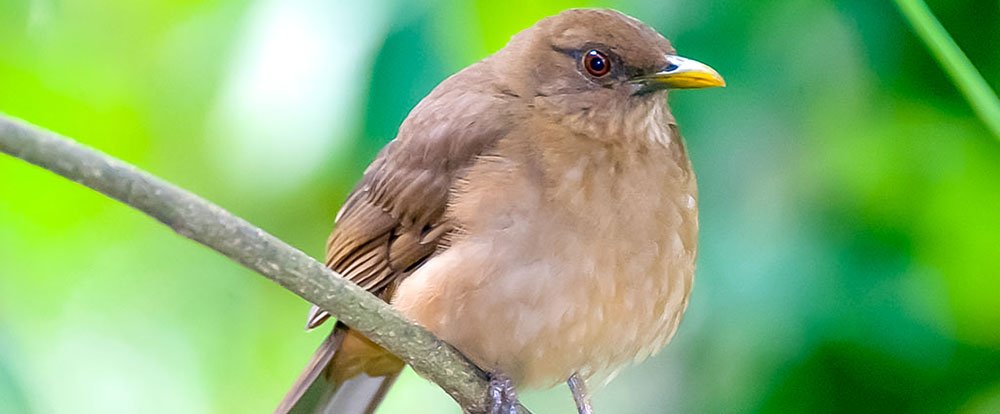
The sisters were dying to see snakes, and sure enough, Koky found a side-striped palm pit viper curled up inside some twisted tree roots. He said he often sees the same snake in the same spot for many days. That’s because tree mice scurry about at night to collect food and they mark their trails with urine to find their way back to their nests. The snake uses its tongue to “smell” the urine trail and then hangs out to wait for a delicious snack. Koky recalled seeing one snake on a stakeout for 18 days until finally he saw the snake nearby with a mouse-shaped belly.
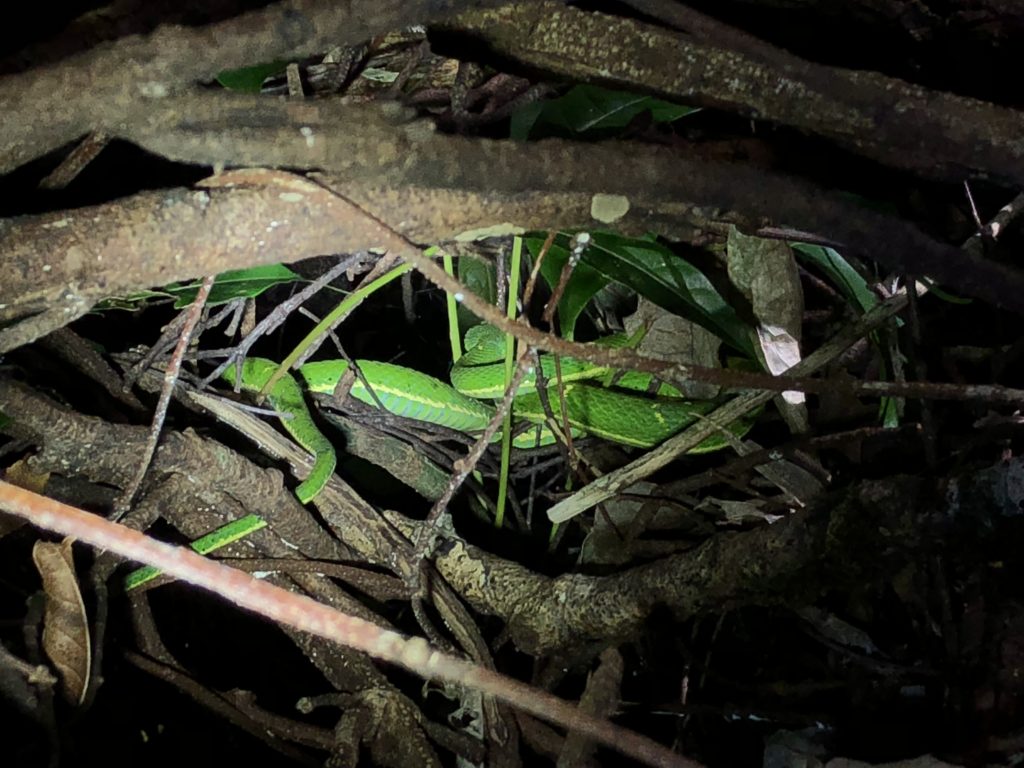
At one point, we saw weird clumps hanging from a vine. Of course, I started to move in to touch them, but Koky stopped me. He said they were called mokuna urens, a seed pod with spiny hairs (worse than a cactus, he said). According to Koky, the plant is pollinated by bats. When the bats probe for nectar, the flower blasts pollen into their faces, which they carry to other flowers.
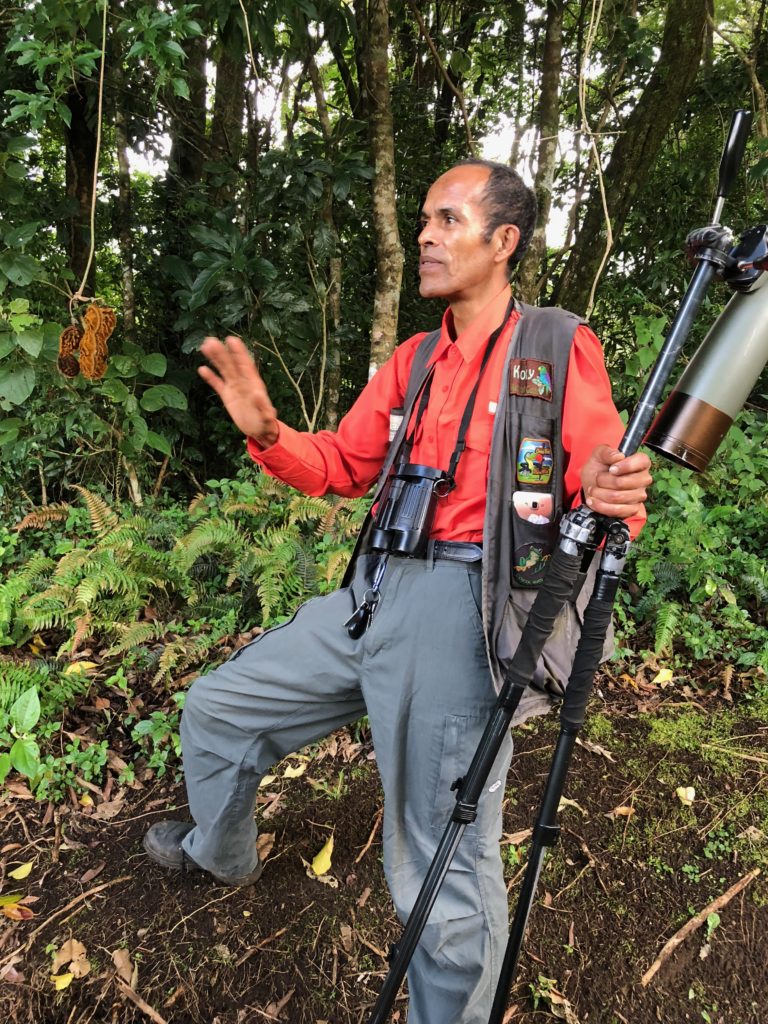
As the morning went on, we saw more interesting plants and animals, heard more wonderful stories, and grew more entranced by the Costa Rican cloud forest. Here are some pics and videos from our day.
We looked up inside this hollow 300-year-old ficus tree. It’s hollow because the tree that had been inside served as host for the ficus, which grew on its branches, sending down roots to the earth. Over time, those roots grew thick and intertwined, taking on the shape of the tree within. Koky said researchers used to think the ficus killed its host (hence the ficus’s nickname, “strangler fig”), but now it’s commonly believed those old trees would have died anyway.
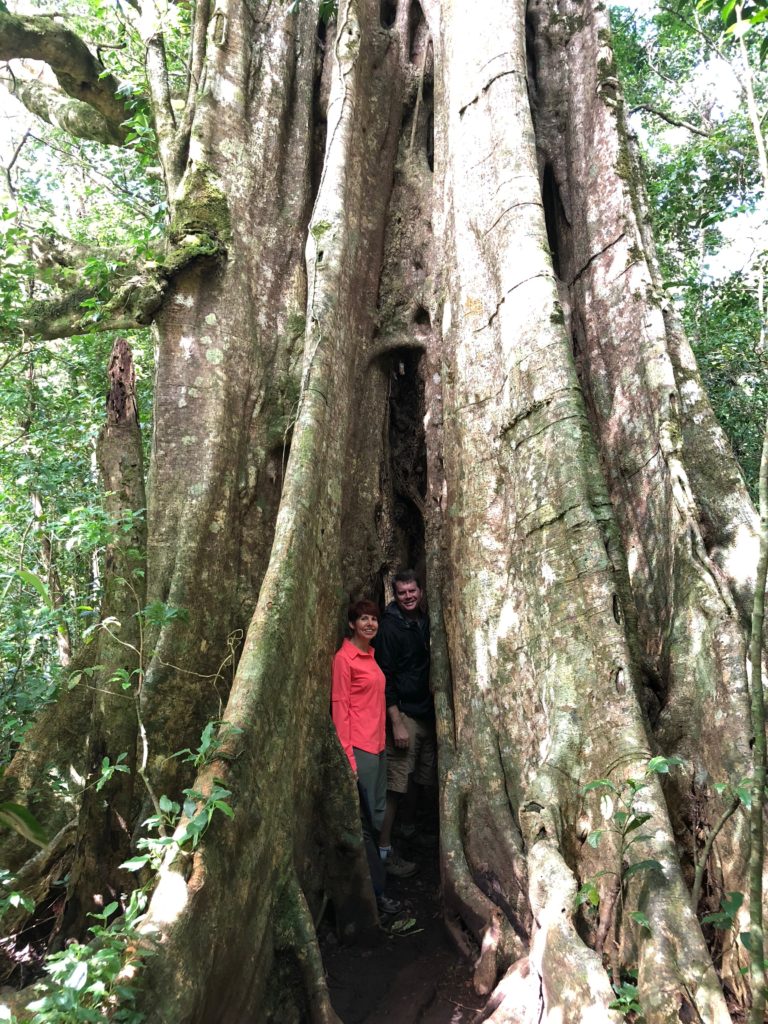
An agouti, which looks like a giant guinea pig, about the size of a miniature schnauzer. Tony and I kept saying, “R.O.U.S.es? I don’t think they exist!” (50 points if you can name the movie.)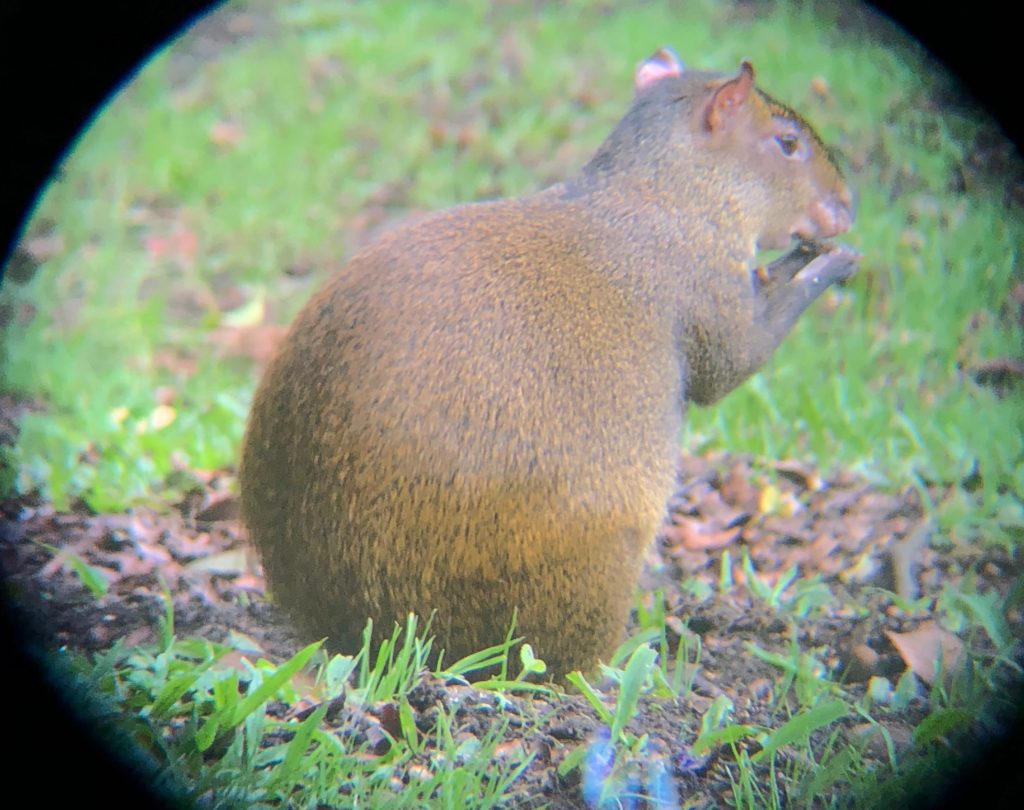
A three-wattled bell bird, which makes the most bizarre electronic “bonk” sound. Watch till the end to hear him.
A bare-necked umbrella bird, which Koky said was unusual to see here. We understood its significance when several other tourists came flying down the path to see it.
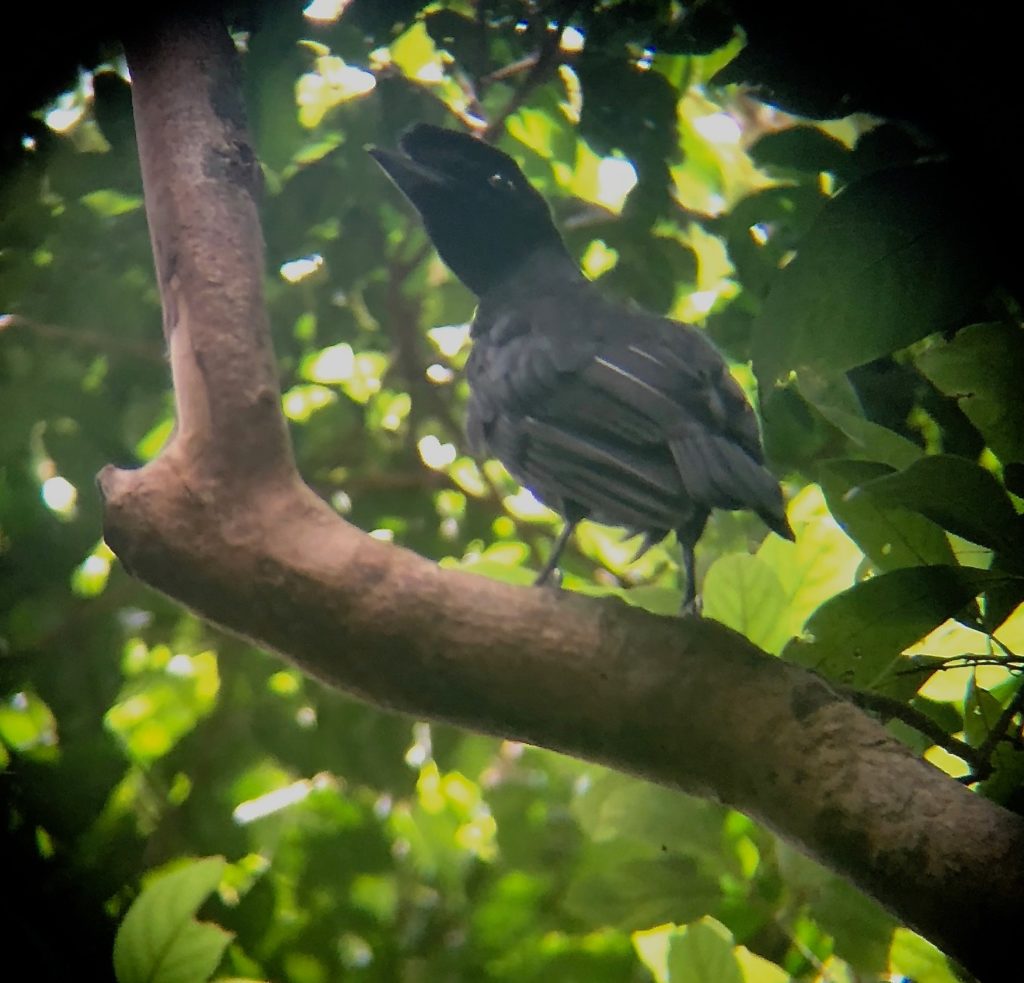
A rainbow-billed toucan. Tony saw it through binoculars, and Koky took this shot for me.

A sleeping baby porcupine. (A bit hard to see … His little hand is grabbing the branch, and his head is tucked to his chest. He has a long prehensile tail hanging down the tree.)
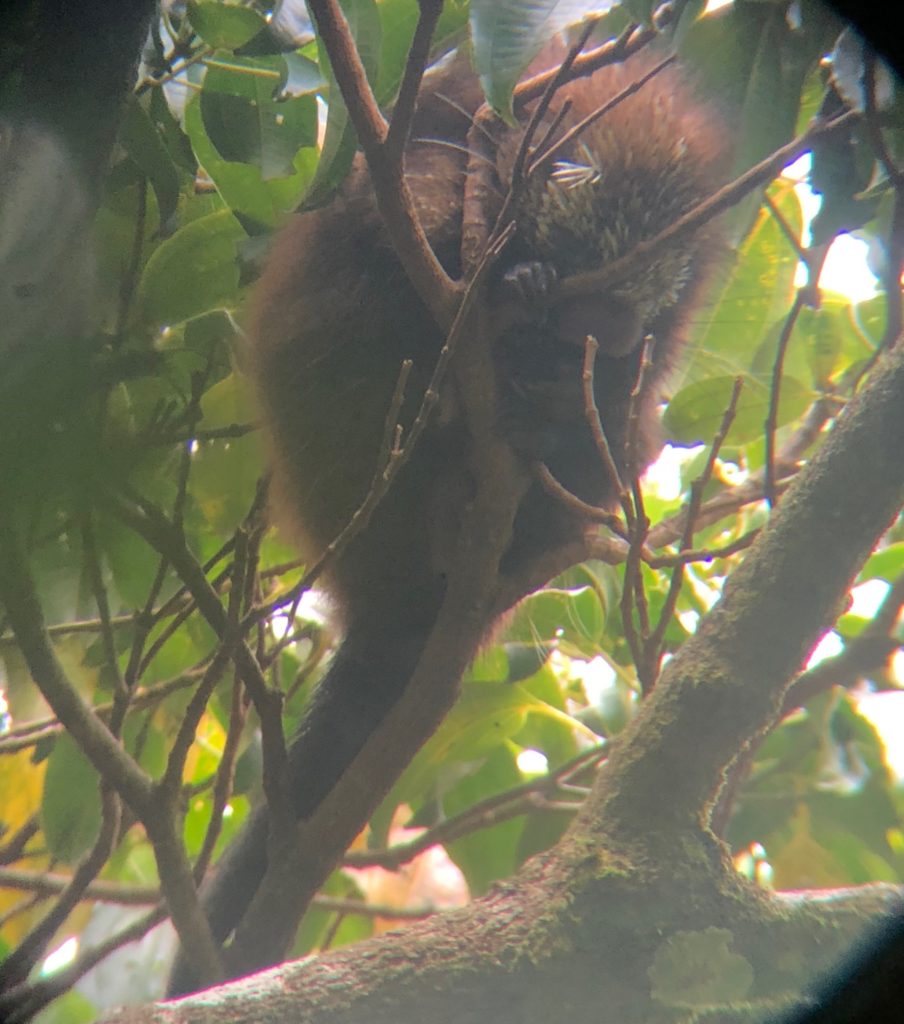
A blue morpho butterfly. With its wings closed, it looks like a drab moth. But then it takes off, spreading its vibrant blue wings.
The resplendent quetzal! This is the rare gem of the cloud forest, which every birder seems intent to find. He and his friends were gnoshing at an avocado tree, and he kept hiding behind foliage. We were ready to give up when finally Koky set up his scope and got a clear shot.
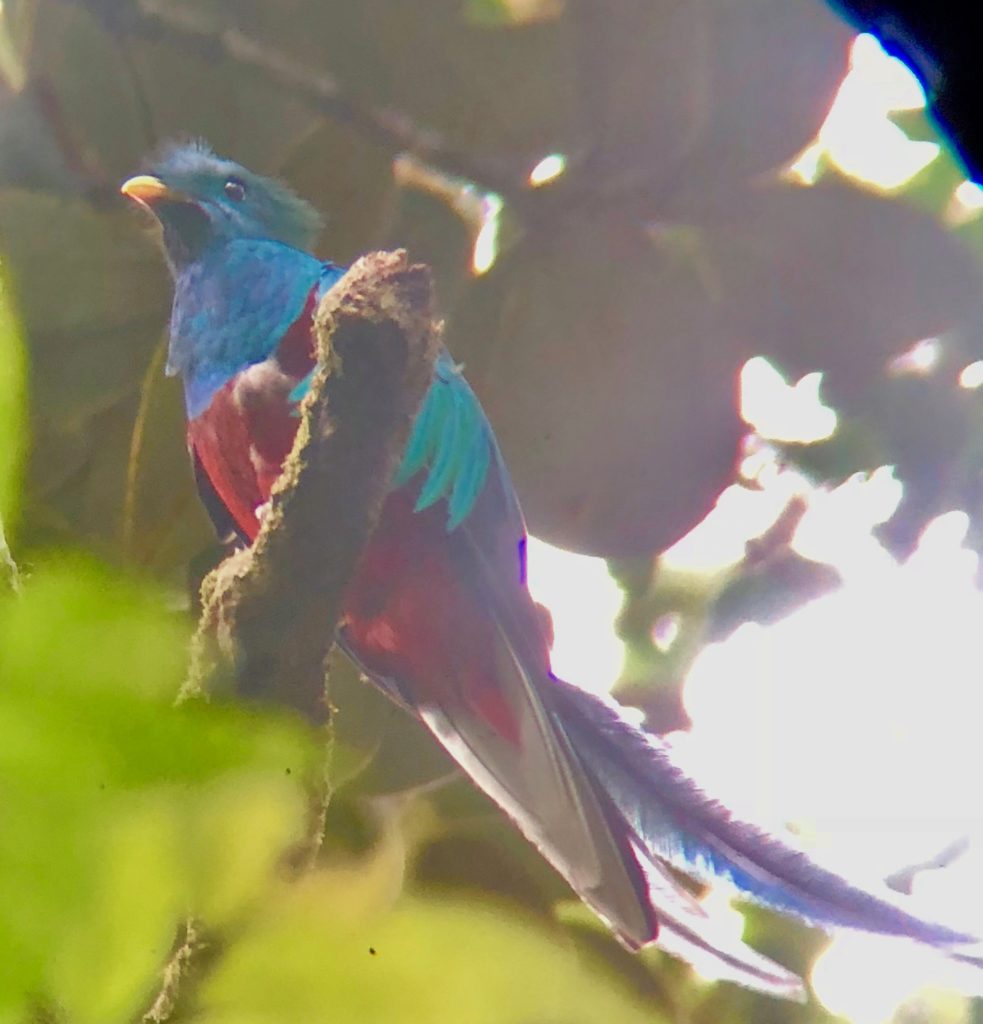
What a day! And we were just getting started.
Tony and I spent the afternoon at a coffee plantation (which I’ll write about later). After tea time, we met up with Koky again and a fun couple from San Antonio, Tim and Anna, for a night walk.
Hiking in the forest at night is something I would ordinarily NEVER do. Just the thought of it makes my stomach turn over with fear. However, with Koky in tow, I felt totally safe and never once worried about getting lost or eaten.
As we entered the the wildlife refuge, he immediately stopped at a patch of plants to point out about a gajillion little life forms. A massive walking stick insect. A pygmy rain frog. A bunch of katydids and grasshoppers.
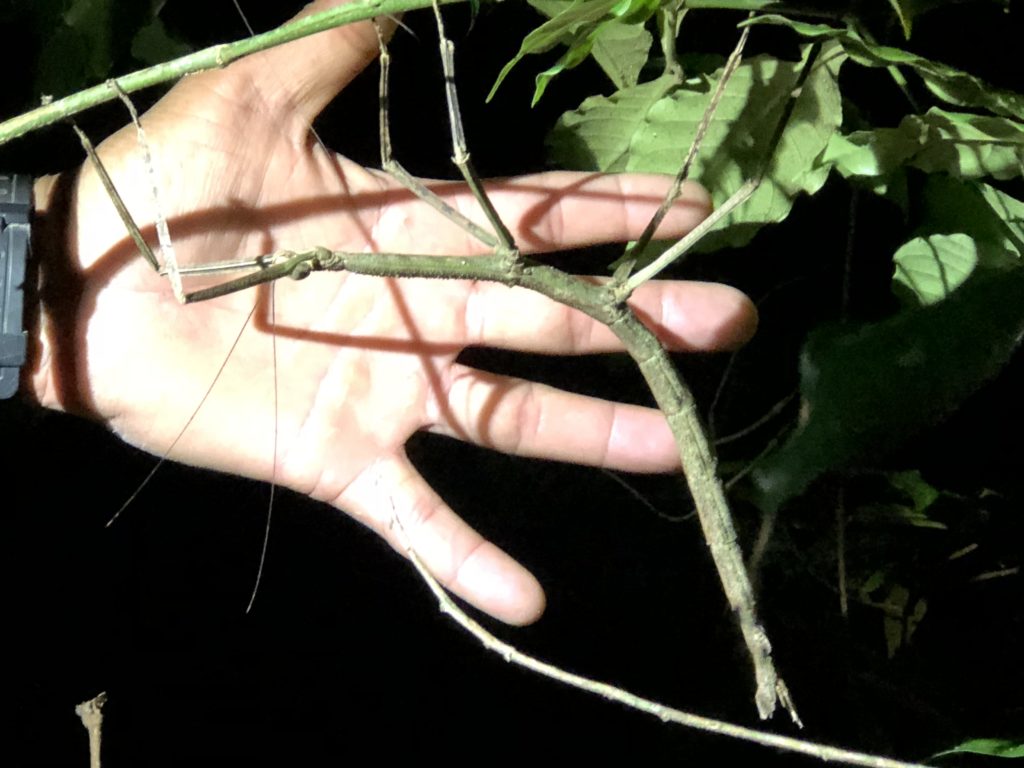
Koky found a scorpion on a tree, some cartoonish yellow mushrooms growing on a fallen tree, a rhinoceros katydid, a leaf katydid, and a glass-winged butterfly.
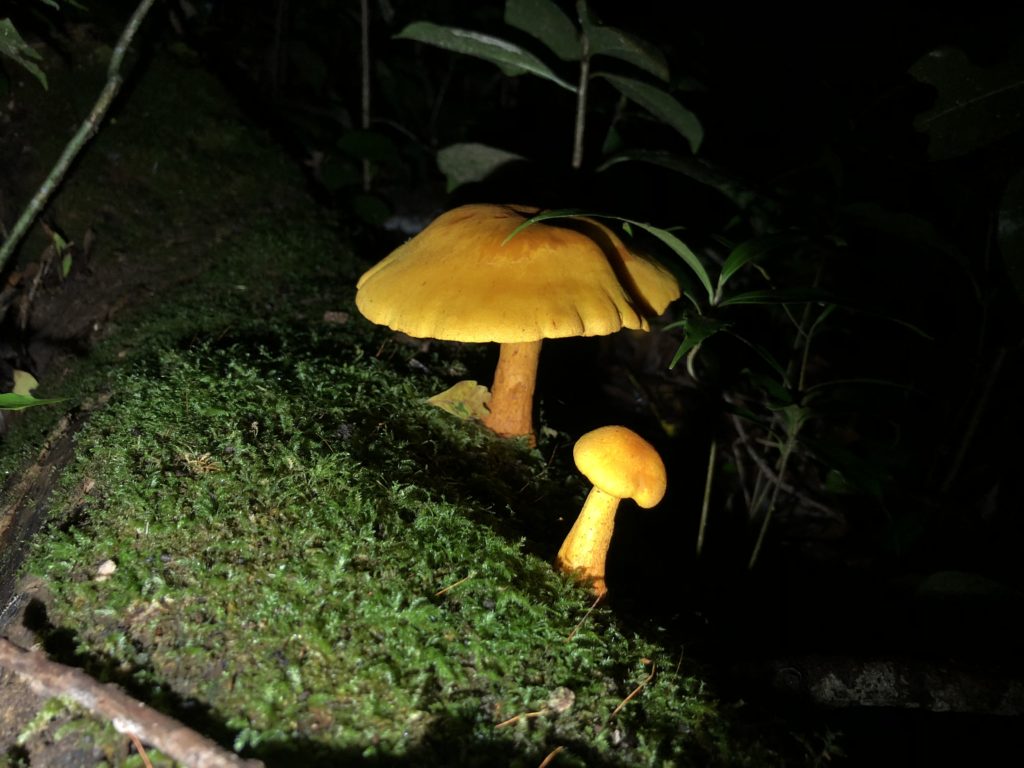
We encountered several groups of leafcutter ants, working their tiny butts off. Some worked in expanding the tunnels, carrying balls of dirt out to the edge of the hole and dumping it. Others carried bits of leaves down into the nest. Koky explained that other ants had the jobs of cleaning the leaves and then coating them with bodily fluids. Eventually, the leaves would develop a fungi that feeds the whole colony, which can number up to 5 million. I could have watched these guys all night.
He stumbled upon this weird creature and admitted he didn’t know what it was. Chatting with a family at the hotel the next morning, we discovered their college-bound son was a budding entomologist. When I showed him the photo, he said, “That’s a velvet worm.” Sure enough, Koky did some research and said it’s been around since prehistoric times.
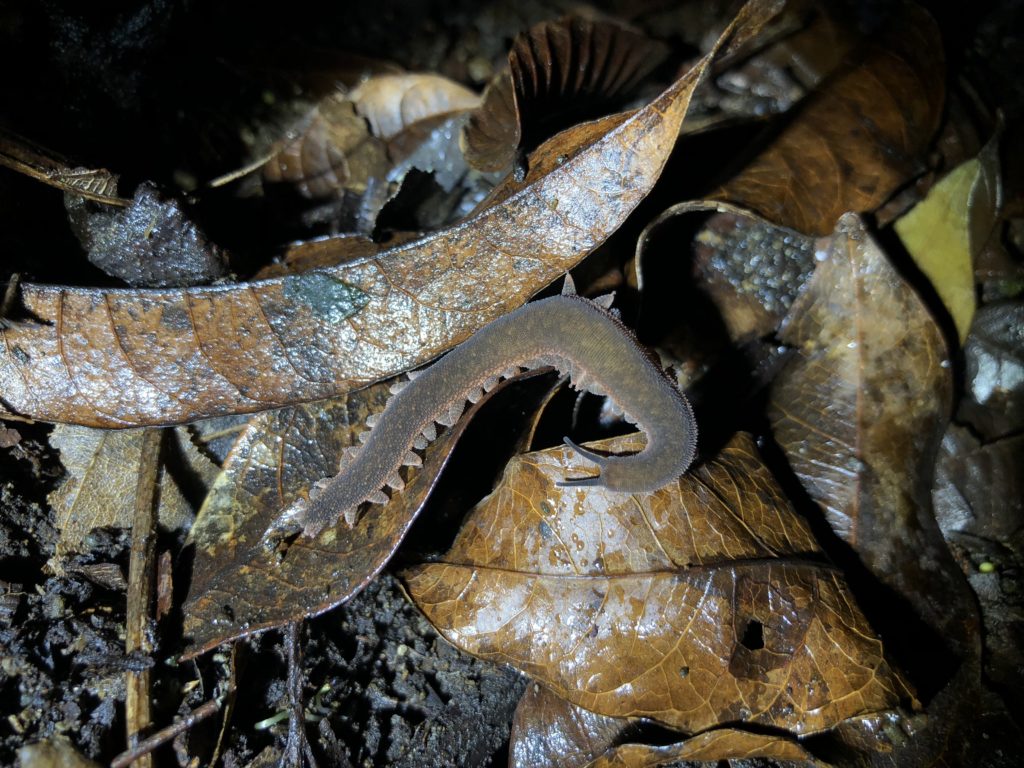
Koky took us to a hole in the mud wall, which was once the nest of a motmot bird. He shone his flashlight into the hole and illuminated an orange-kneed tarantula. Waving a thin stick in the hole to create vibrations, he lured the arachnid out to the edge, where we could see her clearly. Koky explained that tarantulas tend to stay hidden to avoid the tarantula wasp. The wasp paralyzes the tarantula and then lays its eggs in the spider’s abdomen. When they hatch the wasp larvae eat the live tarantula from the inside out. Ugh.
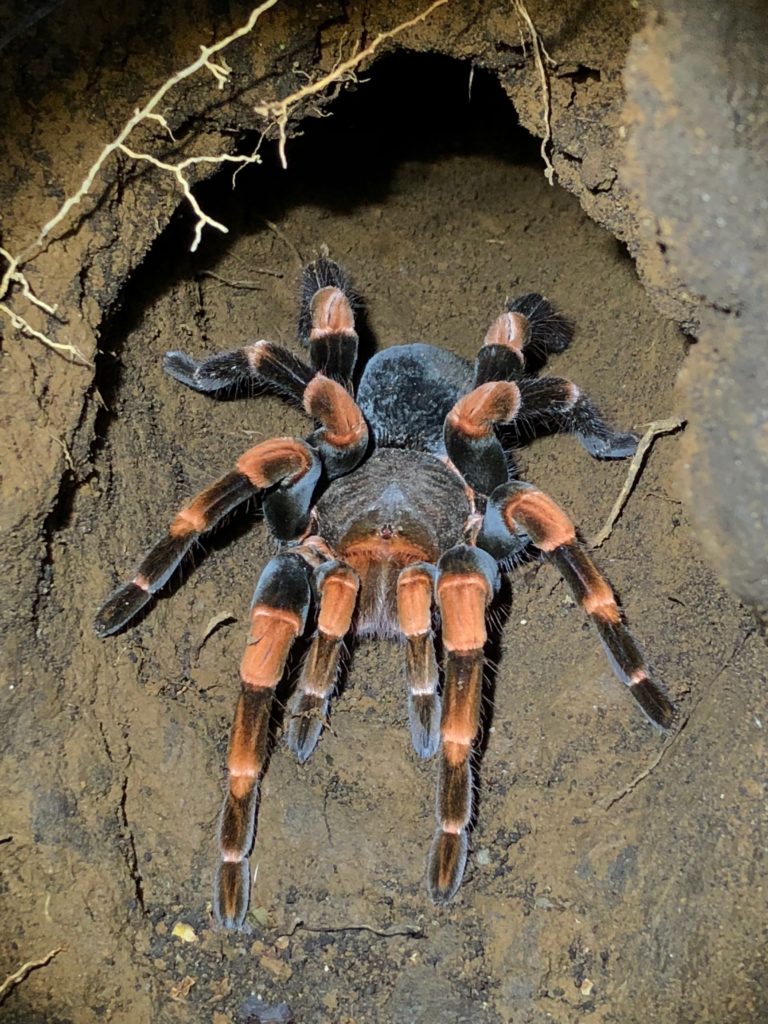
And for the grand finale of our night walk, we saw another side-striped palm pit viper, just hanging out and ready to strike, waiting for some little mice to return from foraging.
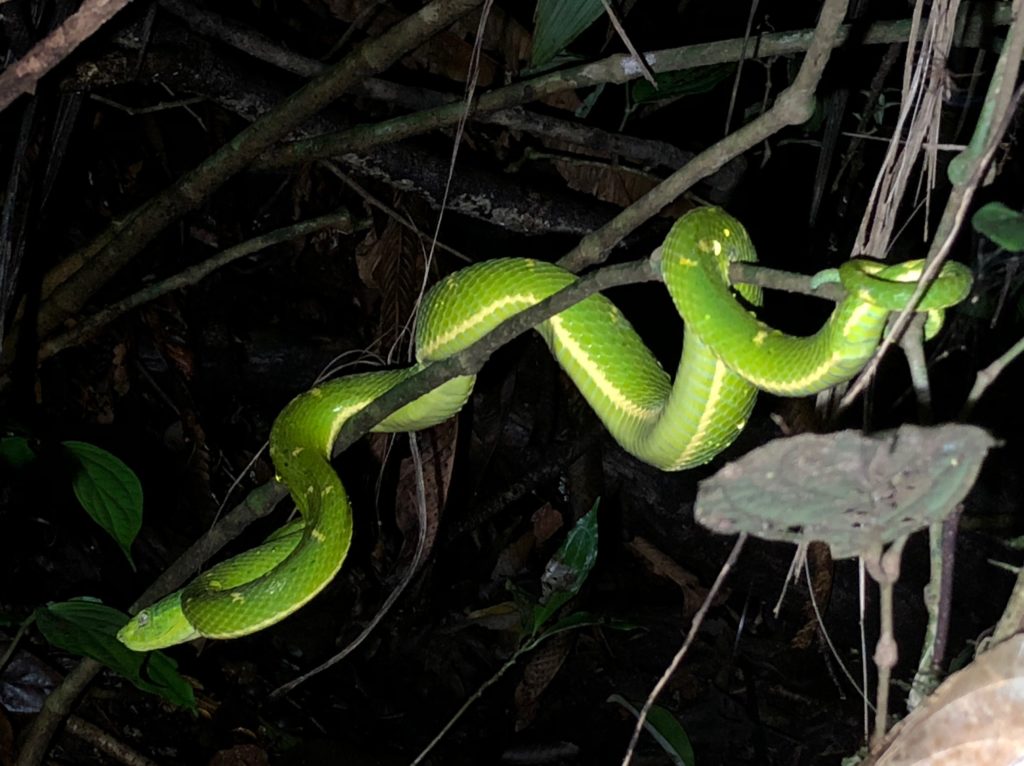
On our way out of the nature reserve, Koky found a sloth in a tree, but it was really too far away to photograph. Still, not a bad night, eh?

